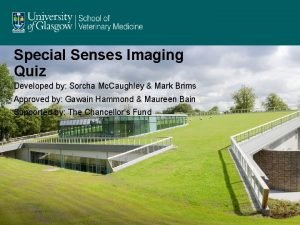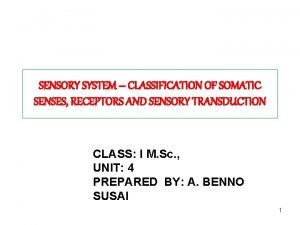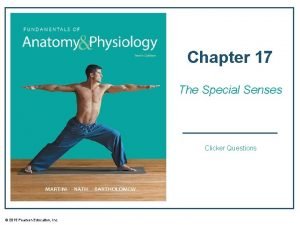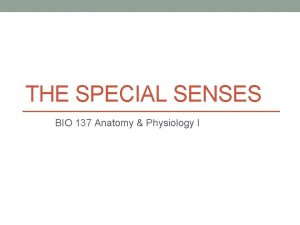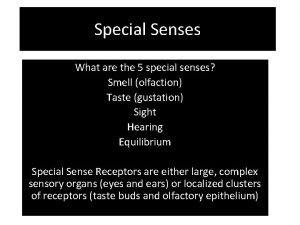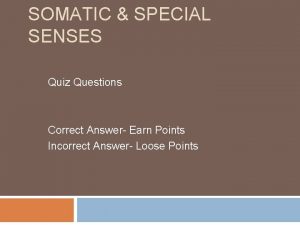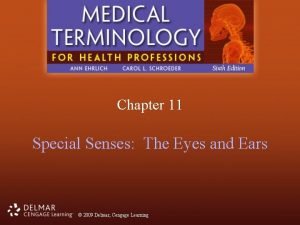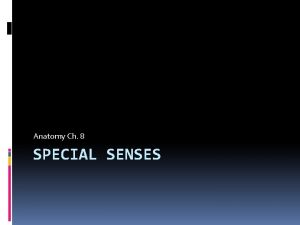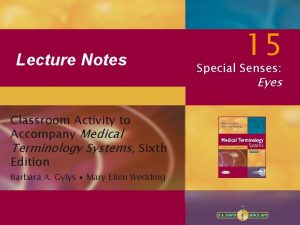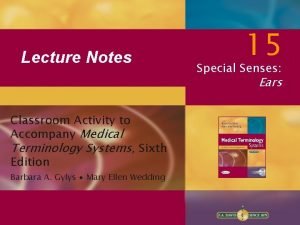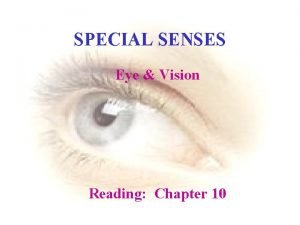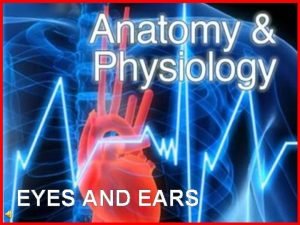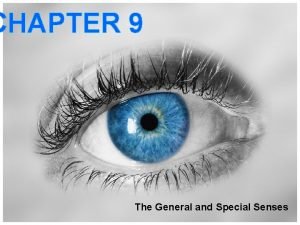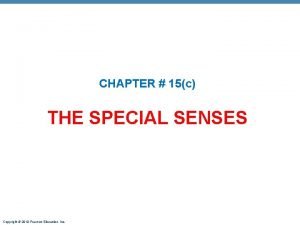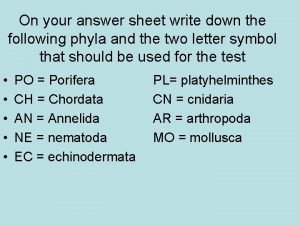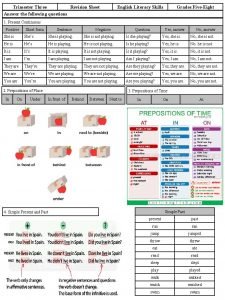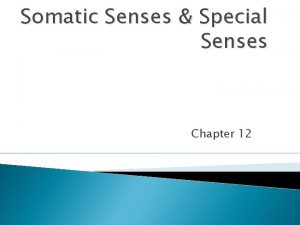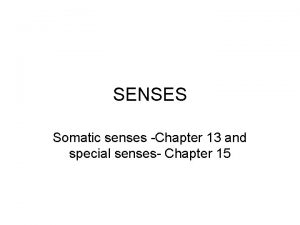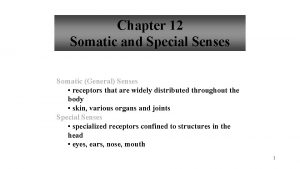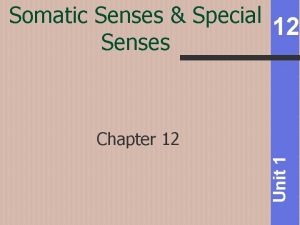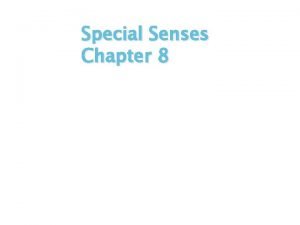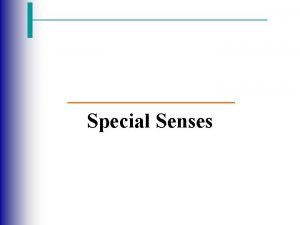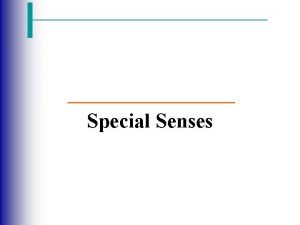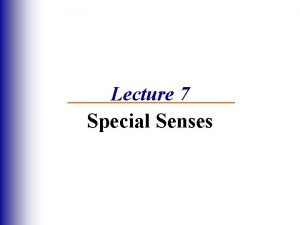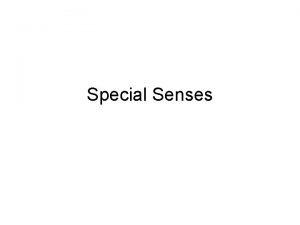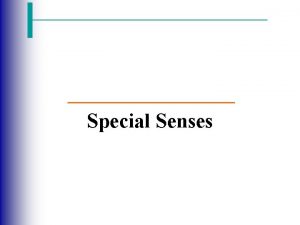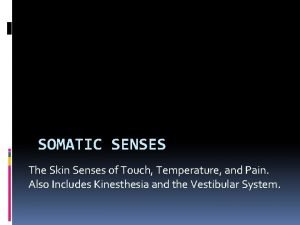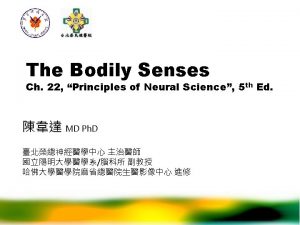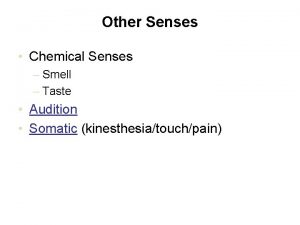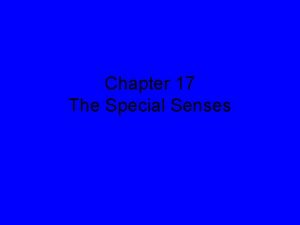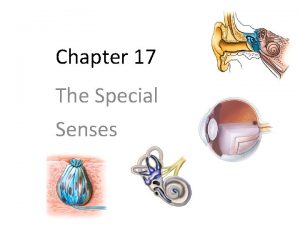SOMATIC SPECIAL SENSES Quiz Questions Correct Answer Earn









































- Slides: 41

SOMATIC & SPECIAL SENSES Quiz Questions Correct Answer- Earn Points Incorrect Answer- Loose Points

Somatic & Special Senses Histology: $100 Question What do you call the condition of associating words with colors ______

Somatic & Special Senses Histology: $100 Answer What do you call the condition of associating words with colors ______

Somatic & Special Senses Histology: $300 Question Why do so many persons in need of treatment fail to undergo cornea transplantation? _____

Somatic & Special Senses Histology: $300 Answer Why do so many persons in need of treatment fail to undergo cornea transplantation? _____ Lack of donor tissue

Somatic & Special Senses Histology: $400 Question A. The auditory nerve pathways carry impulses to the auditory cortices in the? B. Taste receptors are modified? C. The range of human hearing is about? D. The transparent, anterior portion of the eye’s outer tunic is called the?

Somatic & Special Senses Histology: $400 Answer A. The auditory nerve pathways carry impulses to the auditory cortices in the? Temporal B. Taste receptors are modified? Epithelial Lobe cells C. The range of human hearing is about? 20 to 20, 000 vibrations per second D. The transparent, anterior portion of the eye’s outer tunic is called the? Cornea

Receptors/Sensations/Somatic Senses : $200 Question The lens of the eye thickens when A. ciliary processes relax B. ciliary muscles relax C. ciliary muscles contract D. suspensory ligaments pull on the lens capsule

Receptors/Sensations/Somatic Senses action: $200 Answer The lens of the eye thickens when C. ciliary muscles contract

Receptors/Sensations/Somatic Senses action: $300 Question Nausea, vomiting, dizziness, and headache of motion sickness arise from ?

Receptors/Sensations/Somatic Senses action: $300 Answer Nausea, vomiting, dizziness, and headache of motion sickness arise from ? Senses that don’t make sense

Receptors/Sensations/Somatic Senses action: $400 Question A. The region of sharpest vision within the retina is called? B. Floaters cast shadows on the visual receptors are usually located within the? C. Pacinian corpulses are sensory bodies that respond to _____

Receptors/Sensations/Somatic Senses action: $400 Answer A. The region of sharpest vision within the retina is called? Fovea Centralis B. Floaters cast shadows on the visual receptors are usually located within the? Viterous Humor C. Pacinian corpulses are sensory bodies that respond to heavy or deep Pressure

pain / equilibrium $100 Question A. Pain that feel like it is coming from a part other than the part being stimulated is called B. Pain that occurs when the brain projects the sensation back to the original source in the body from which the pain originated?

pain / equilibrium $100 Answer A. Pain that feel like it is coming from a part other than the part being stimulated is called Referred pain B. Pain that occurs when the brain projects the sensation back to the original source in the body from which the pain originated? Projection

pain / equilibrium $200 Question Pain receptors A. are widely distributed in the nerve tissues of the brain B. are among the most specialized of the receptors C. are generally stimulated by factors that can cause tissue damage D. tend to adapt rapidly

pain / equilibrium $200 Answer Pain receptors C. are generally stimulated by factors that can cause tissue damage

Other Somatic & Special Senses : $100 Question Which of the following is NOT part of the INNER TUNIC of the eye A. choroid coat B. ciliary body C. sclera D. retina

Other Somatic & Special Senses : $100 Question Which of the following is NOT part of the INNER TUNIC of the eye C. sclera

Mixed Bag: $100 Question Worldwide, blindness is most commonly caused by changes in the? The ___lines the inner surface of the eyelid and covers the anterior surface of the eye

Mixed Bag: $100 Answer Worldwide, blindness is most commonly caused by changes in the? Cornea The ___lines the inner surface of the eyelid and covers the anterior surface of the eye Conjunctiva

Mixed Bag: $300 Question Night blindness is most commonly caused by? The stapes transmits vibrations to the inner ear through? The adjustment of the thickness of the lens to make close vision possible is called?

Mixed Bag: $300 Answer Night blindness is most commonly caused by? Improper The stapes transmits vibrations to the inner ear through? Oval diet window The adjustment of the thickness of the lens to make close vision possible is called? Accommodation

Mixed Bag: $400 Question A. When radial muscles of the iris contract, the diameter of the pupil (increases or decreases) B. The ___ connects the middle ear with the throat? C. The disorder called glaucoma is usually caused by excessive accumulation of? D. ___ receptors are the only receptors in viscera whose stimulation produces sensation

Mixed Bag: $400 Answer A. When radial muscles of the iris contract, the diameter of the pupil Decreases B. The ___ connects the middle ear with the throat? Auditory C. The disorder called glaucoma is usually caused by excessive accumulation of? Aqueous or Eustachian tube humor D. ___ receptors are the only receptors in viscera whose stimulation produces sensation Pain

Mixed Bag: $500 Question A. Which of the following would cause a form of conductive deafness A. Damage to the auditory tube B. Torn tympanic membrane C. Use of streptomycin D. Tumor in the brain B. If you enter a room and smell a strong odor, but the odor soon seems to fade away, you have experienced?

Mixed Bag: $500 Answer A. Which of the following would cause a form of conductive deafness Torn tympanic membrane B. If you enter a room and smell a strong odor, but the odor soon seems to fade away, you have experienced? Sensory Adaptation

Receptors/Sensations/Somatic Senses regulation: $100 Question The interference with vision and the feeling of numbness in the limbs experienced by a person with a migraine is probably caused by A. blood pulsating through cranial vessels B. vasodilation of cerebral vessels C. contraction of skeletal muscles D. cerebral blood dificiency

Receptors/Sensations/Somatic Senses regulation: $100 Answer The interference with vision and the feeling of numbness in the limbs experienced by a person with a migraine is probably caused by D. cerebral blood deficiency

Receptors/Sensations/Somatic Senses regulation: $200 Question Which of the following structures contain pain receptors? A. blood vessels within the brain B. Neither meninges on the surface nor blood vessels within the brain C. Meninges of the surface of the brain D. Meninges on the surface and blood vessels within the brain

Receptors/Sensations/Somatic Senses regulation: $200 Answer Which of the following structures contain pain receptors? D. Meninges on the surface and blood vessels within the brain

Receptors/Sensations/Somatic Senses regulation: $400 Question A. The set of color receptors within the retina are sensitive to lights that are A. red, blue, and yellow B. orange, green, and purple C. red, green, and blue D. green, yellow, and purple B. ___are more sensitive to light, but ___ are important for color.

Receptors/Sensations/Somatic Senses regulation: $400 Answer A. The set of color receptors within the retina are sensitive to lights that are C. red, green, and blue B. ___are more sensitive to light, but ___ are important for color . Rods, Cones

Receptors/Sensations/Somatic Senses regulation: $500 Question A. Olfactory receptor cells are best described as B. The hearing receptors are contained within the? C. The ____ region is also known as the blind spot D. In which sex, does synesthesia seem to be more common?

Receptors/Sensations/Somatic Senses regulation: $500 Answer A. Olfactory receptor cells are best described as Neurons B. The hearing receptors are contained within the? Organ of Corti C. The ____ region is also known as the blind spot Optic Disc D. In which sex, does synesthesia seem to be more common? Females

Somatic & Special Senses Physiology: $200 Question A. Which of the following is NOT a primary taste sensation? a. bitter b. sweet c. salty d. pungent B. Rod cells contain the pigment a. cyanolabe b. visual purple c. erythrolabe d. rhodopsin

Somatic & Special Senses Physiology: $200 Answer A. Which of the following is NOT a primary taste sensation? d. pungent B. Rod cells contain the pigment d. rhodopsin

Somatic & Special Senses Physiology: $300 Question A. The auditory ossicles are located within the a. inner ear c. bony labyrinth b. middle ear d. external ear B. Blowing your nose improperly may cause an infection within the auditory tube to spread into the a. cochlea b. inner ear c. outer ear d. middle ear

Somatic & Special Senses Physiology: $300 Answer A. The auditory ossicles are located within the b. middle ear B. Blowing your nose improperly may cause an infection within the auditory tube to spread into the d. middle ear

Somatic & Special Senses Physiology: $500 Question A. A dogs visual world is much like that of a person with? B. Frequent or prolong exposure to sounds with intensities above ___ can cause hearing loss. C. Receptors stimulated by changes in temperature are called? D. List the path that light follows as it enters the eye E. Olfactory receptors are examples of?

Somatic & Special Senses Physiology: $500 Answer A. A dogs visual world is much like that of a person with? Colorblindness B. Frequent or prolong exposure to sounds with intensities above _85 d. B__ can cause hearing loss. C. Receptors stimulated by changes in temperature are called? thermoreceptors D. List the path that light follows as it enters the eye Cornea-aqueous humor- lens- vitreous humor E. Olfactory receptors are examples of? Chemoreceptors
 Chapter 10 somatic and special senses
Chapter 10 somatic and special senses What is the difference between somatic and special senses
What is the difference between somatic and special senses Somatic and special senses
Somatic and special senses Special vs general senses
Special vs general senses Special senses quiz
Special senses quiz Classification of somatic senses
Classification of somatic senses Chapter 17 special senses answer key
Chapter 17 special senses answer key Bio 137
Bio 137 Anatomy labeled
Anatomy labeled The cones of the retina are coursera quiz answers
The cones of the retina are coursera quiz answers Cranial nerves skull openings
Cranial nerves skull openings Learning exercises chapter 11 medical terminology
Learning exercises chapter 11 medical terminology Anatomy and physiology chapter 8 special senses
Anatomy and physiology chapter 8 special senses Eye anatomy
Eye anatomy Physiology
Physiology Signal conclusion
Signal conclusion Building vocabulary activity: the special senses
Building vocabulary activity: the special senses Building vocabulary activity: the special senses
Building vocabulary activity: the special senses Houses the receptors for hearing
Houses the receptors for hearing Chapter 10 special senses
Chapter 10 special senses The general senses
The general senses Special senses the eyes and ears
Special senses the eyes and ears The general and special senses chapter 9
The general and special senses chapter 9 Pearson
Pearson Chapter 15 special senses
Chapter 15 special senses 1. choose the correct answer.
1. choose the correct answer. In pairs discuss the questions
In pairs discuss the questions On your answer sheet answer the following questions
On your answer sheet answer the following questions In your answer sheet answer the following questions
In your answer sheet answer the following questions Ace strategy apush
Ace strategy apush Leq examples ap world
Leq examples ap world 7elife com
7elife com How much did wanda pay in taxes this pay period?
How much did wanda pay in taxes this pay period? Rhymes with earn
Rhymes with earn Enjoy fiilinin 3. hali
Enjoy fiilinin 3. hali How much does wanda earn per hour
How much does wanda earn per hour When the two brothers race home to beat the storm, doodle
When the two brothers race home to beat the storm, doodle 5-5 standard form
5-5 standard form How to earn back your parents trust
How to earn back your parents trust How did business leaders earn the nickname robber barons
How did business leaders earn the nickname robber barons Fm compensation plan
Fm compensation plan Earn value management
Earn value management




